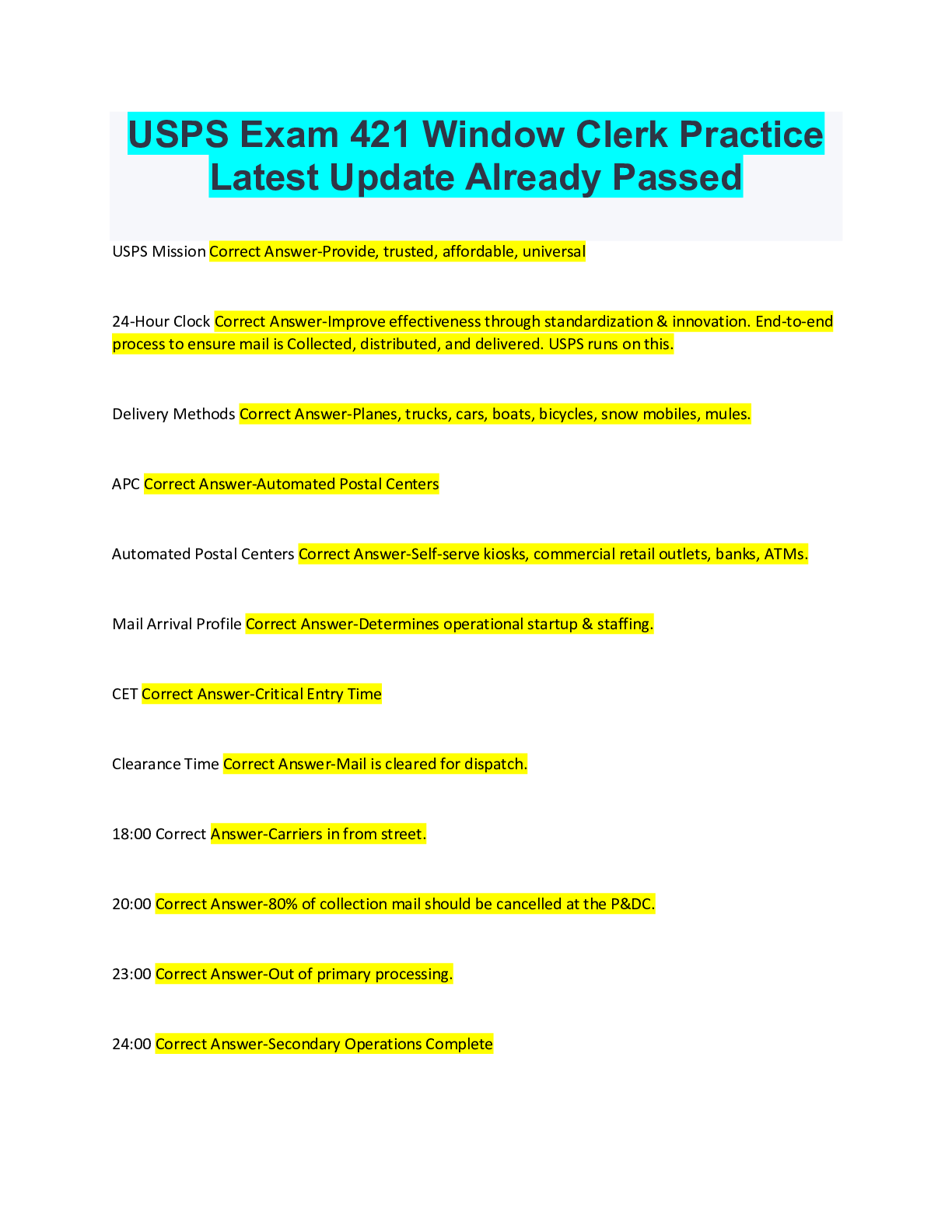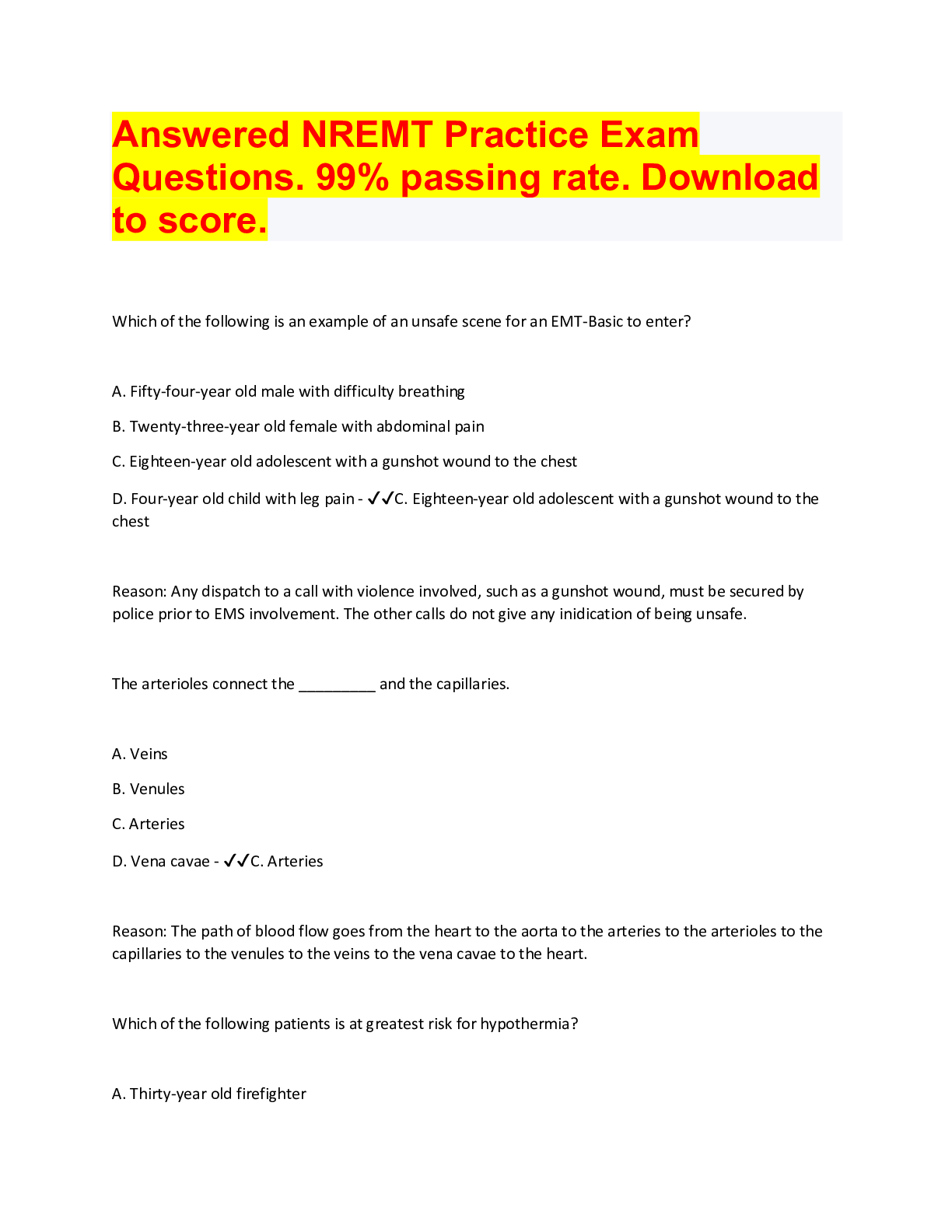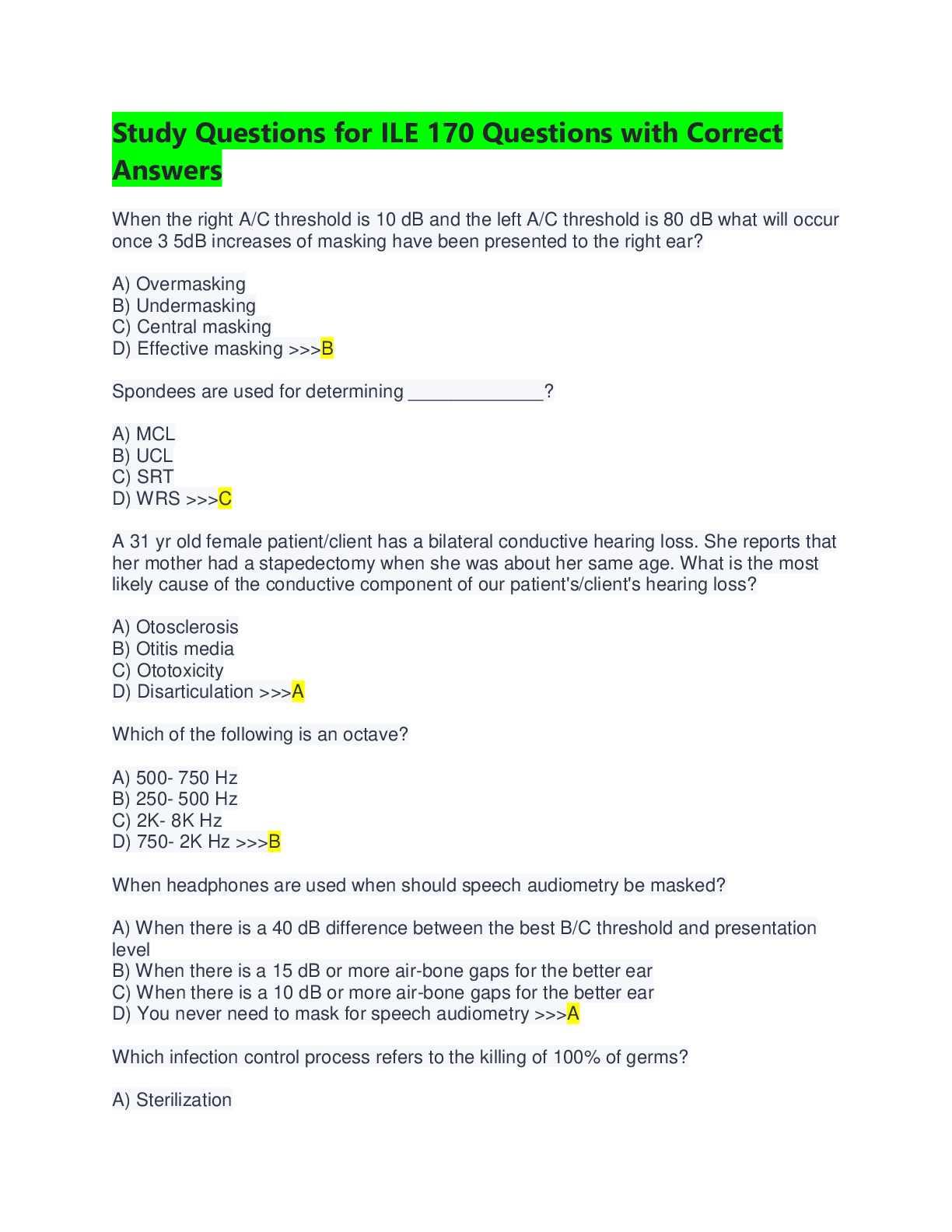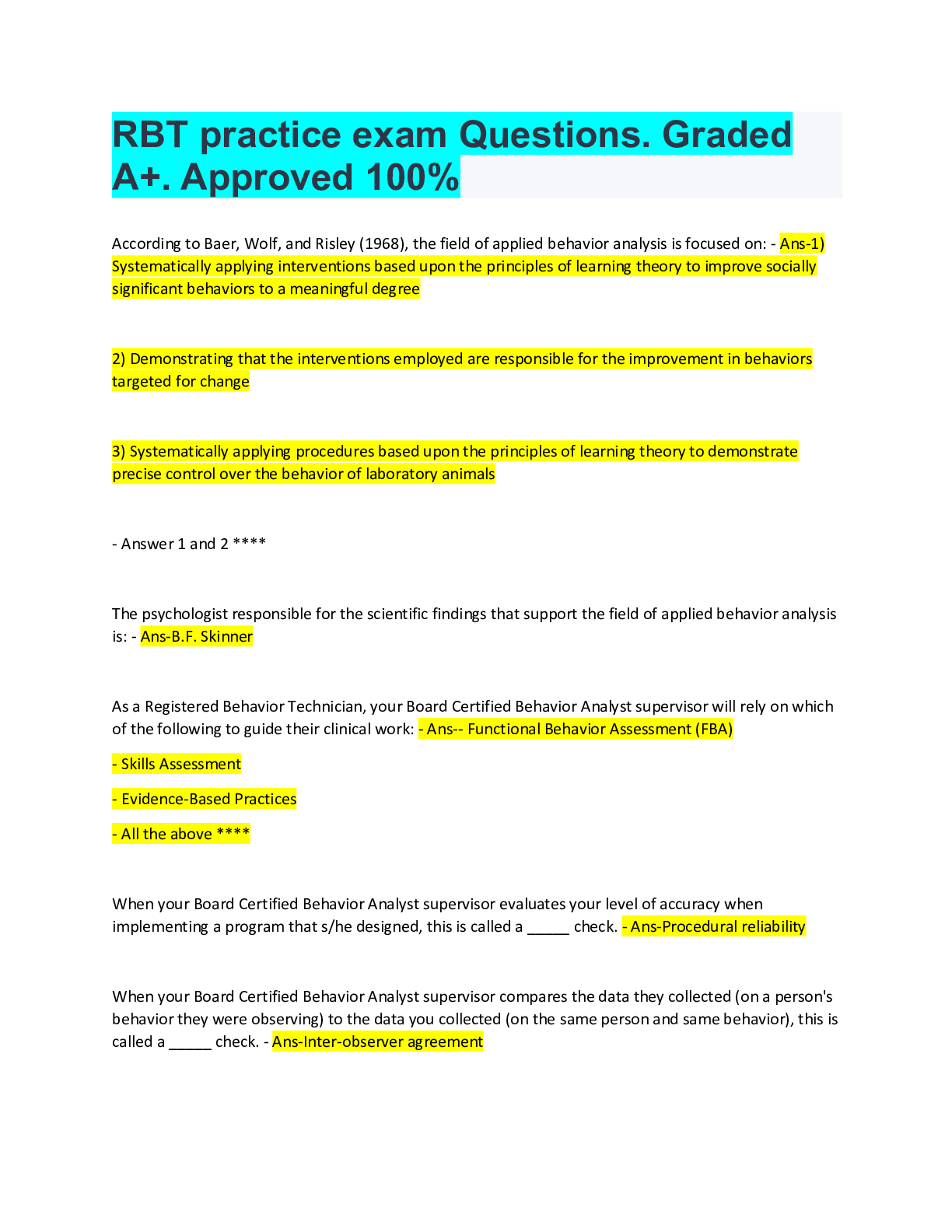Social Sciences > QUESTIONS & ANSWERS > ASWB Complete Practice Exam Questions. 170 Questions with Rationale Answers (All)
ASWB Complete Practice Exam Questions. 170 Questions with Rationale Answers
Document Content and Description Below
. Which of the following is NOT true about motivation to change? A. Motivation fluctuates from one time to another. B. Motivation can be increased by working to remove barriers to change. C. Mot... ivation is driven by hope or the belief that life can be different. D. Motivation that is imposed by external forces is more salient than that which is intrinsic. - Ans-D Motivation is a state of readiness or eagerness to change, which fluctuates from one time to another. The role of the social worker is to create an atmosphere that is conducive to change and to increase a client's intrinsic motivation, so that change arises from within rather than being imposed from without. If a client is driven to change internally, it is much more likely that the change effort will be sustained. A technique to increase motivation is to work to remove barriers and instill hope or the belief that life can be different. 2. Evidence-based social work practice can BEST be defined as: A. Interventions that a social worker has gained training and experience in delivering B. Treatment that yields the most cost-effective outcomes according to a cost-benefit analysis C. Decision making based on the conscientious, explicit, and judicious use of research knowledge, clinical expertise, social work values, and client wishes D. Practice evaluations that adhere to scientific principles - Ans-C Evidence-based practice (EBP) combines well-researched interventions with clinical experience and ethics, as well as client preferences and culture, to guide and inform the delivery of treatments and services. Social workers, clients, and others must work together in order to identify what works, for whom, and under what conditions. This approach ensures that the treatments and services, when used as intended, will have the most effective outcomes as demonstrated by the research. 3. What are the stages of change in sequential order? A. Precontemplation, preparation, contemplation, action, maintenance, and relapse B. Preparation, action, precontemplation, contemplation, maintenance, and relapse C. Preparation, precontemplation, contemplation, action, maintenance, and relapse D. Precontemplation, contemplation, preparation, action, maintenance, and relapse - Ans-D Precontemplation is denial or ignorance of the problem. It is followed by contemplation in which there is ambivalence about making change. Then comes preparation or experimenting with small changes. Action moves toward achieving a goal, whereas maintenance sustains a new behavior and avoids relapse, which can lead to feelings of frustration and failure. 4. Which of the following is NOT an essential step in ethical problem solving? A. Identifying the ethical standards that may be compromised B. Determining whether there is an ethical dilemma C. Weighing ethical issues in light of social work values and principles D. Asking a supervisor to monitor practice to identify new ethical issues or dilemmas - Ans-D A social worker, not his or her supervisor, should monitor practice to identify whether new issues or dilemmas arise. 5. A young boy is stopped by a police officer and claims that he is a member of the armed forces, though it is obvious that he is not. This assertion by the boy is MOST likely a: A. Comorbid thought B. Dissociation C. Folie à deux D. Delusion - Ans-D A delusion is a false, fixed belief despite evidence to the contrary (i.e., believing something that is not true). Comorbid means existing at the same time. Dissociation is a change in memory, perception, or consciousness. Folie à deux is a shared delusion. 6. A social work administrator is having trouble finding a group home manager for a new program scheduled to open in 2 weeks. Further delays in locating staff will delay clients from moving into the program. The administrator temporarily hires her niece, who just graduated with a social work degree, for this position. This action is: A. Ethical because the niece is clearly qualified for the position B. Unethical because this is a conflict of interest C. Ethical because the position is temporary and ensures clients get the services needed D. Unethical because clients will experience staff turnover when a new manager is hired - Ans-B Social workers should avoid situations interfering with impartial judgment. Hiring a family member creates a dual relationship and should be avoided. 7. A social worker is interested in seeing the extent to which current clients are satisfied with a new relapse prevention program. The social worker distributes a client satisfaction survey to those in the program. The social worker then collects the surveys and analyzes the results that are presented to a management team in the agency. The social worker is conducting which type of evaluation? A. Summative B. Experimental C. Quasi-experimental D. Formative - Ans-D Formative evaluations examine the process of delivering services, whereas summative evaluations examine the outcomes. Formative evaluations are ongoing processes that allow for feedback to be implemented during service delivery. These types of evaluations allow social workers to make changes as needed to help achieve program goals. Summative evaluations occur at the end of services and provide an overall description of their effectiveness. Summative evaluation examines outcomes to determine whether objectives were met. The design described is not experimental—which requires a control group and randomization of assignment—or quasi-experimental, which does not require randomization, but has more support for causal inferences than does preexperimental designs. 8. Which of the following is an example of social stratification? A. A child is not included in group activities in school because of his or her poor social skills. B. Children who are violent need to be segregated from their peers. C. A child with social deficits is assumed to be delayed in cognition without additional assessment. D. Children from affluent households receive a better public education than those from low-income households. - Ans-D Stratification refers to structured inequality of entire categories of people in society who have unequal access to social rewards. Stratification applies to individuals based on ethnic and racial background, social status, and/or other factors. 9. During an intake interview, a client reports that she is extremely depressed and has self-destructive thoughts. She has had prior suicide attempts, but tells the social worker not to worry as she won't "do it again." The social worker should FIRST: A. Tell the client that her decision not to harm herself is a good one B. Explore with the client what is causing her depression C. Conduct a safety assessment D. Refer the client to a psychiatrist for a medication evaluation - Ans-C Despite the client's report that she will not act on her thoughts, she is at risk because she has had these feelings and has acted on them in the past. The case vignette does not describe the social worker taking any action yet. A safety assessment will determine the severity of the depression and whether the client is at risk for a suicide attempt. It must be done FIRST before any other action is taken. 10. A client with a Social Anxiety Disorder will MOST likely be prescribed which of the following medications to take on an ongoing basis? A. Zoloft (sertraline) B. Mellaril (thioridazine) C. Thorazine (chlorpromazine) D. Valium (diazepam) - Ans-A The primary medications used to treat social anxiety disorder are selective serotonin reuptake inhibitors (SSRIs), which were first developed to treat depression. They have been found to be effective in the treatment of a wider range of disorders. Zoloft (sertraline) is an SSRI. Benzodiazepines, such as Valium (diazepam), reduce levels of anxiety. However, they are habit-forming and sedating, so they are typically prescribed for only short-term use. Mellaril (thioridazine) and Thorazine (chlorpromazine) are antipsychotic medications for the treatment of psychosis. 11. A social worker is appointed by the court to conduct a child custody evaluation for a couple that is divorcing. The mother reports that her husband is verbally abusive, controlling, and neglects the children when they are in his care. She reports that the children have missed a lot of school when staying with their father because he does not assist with getting them ready for school or doing their homework. The father states that his wife is lazy, irresponsible, and cannot meet the children's basic needs. He reports that the school frequently has to provide lunch for the children because the mother does not supply it when they are in her care. In order to BEST evaluate the legitimacy of the information, the social worker should: A. Ask the husband and wife to put their allegations in writing and sign them, attesting to their accuracy B. Determine whether the husband or wife have had any past instances with being untruthful C. Always speak to the husband and wife together so that they are more likely to be honest D. Obtain information from school personnel and records after obtaining parental consent - Ans-D Collateral information is often used when the credibility and validity of information obtained from a client or others is questionable. For example, child custody cases are inherently characterized by biased data within an adversarial process. Social workers should use data from neutral parties, such as the school, because this information has higher integrity. 12. A social worker is facilitating a psychotherapy group for individuals who are in recovery from substance abuse. After group, a client mentions that she has been having problems dealing with job stress without the use of substances. In order to meet this client's needs, the social worker should: A. Recommend that the client see the social worker individually in addition to the group therapy because she appears to need some additional support B. Suggest that the client bring this topic up in the group next week to see if others are having similar problems C. Evaluate whether group therapy is the best treatment modality for the client due to the issue being mentioned to the social worker outside of the group context D. Determine if there is an employee assistance program in the client's work setting to assist - Ans-B In group therapy, the group is the major helping agent. Issues should be brought back to the group to address. There is no need for the client to see the social worker for individual therapy. Contacting an employee assistance program would breach confidentiality. 13. An 11-year-old child would like to start helping around the house with chores. She approaches her mother many times, but is told she cannot assist because "she won't do it right." During several attempts to do things on her own, she is scolded. According to psychosocial development theory, she may experience doubts in her abilities due to a crisis in which of the following stages? A. Industry versus inferiority B. Initiative versus guilt C. Autonomy versus shame/doubt D. Generativity versus stagnation - Ans-A Industry versus inferiority—From age 6 to puberty, children begin to develop a sense of pride in their accomplishments. If children are encouraged and reinforced for their initiative, they begin to feel industrious and feel confident in their ability to achieve goals. If this initiative is not encouraged and is restricted, children begin to feel inferior, doubting their abilities. 14. A social worker employed in a hospital is asked to use a SOAP format in a client's record. In this format, the "A" stands for: A. Action plan B. Assessment C. Active treatment D. Adjustments to services needed - Ans-B SOAP stands for Subjective, Objective, Assessment, and Plan. In the Assessment portion, a social worker pulls together objective and subjective findings and consolidates them into a short assessment. 15. Aphasia is BEST defined as difficulty with: A. Walking or running B. Common motor skills such as combing hair, despite normal strength C. Understanding language or using language to speak or write D. Recognizing familiar objects - Ans-C Aphasia is a change in cognition (mental ability) that is characterized by difficulty understanding language or using language to speak or write. Difficulty with common motor skills is known as ataxia. Inability to recognize familiar objects is labeled agnosia. 16. Culture-bound syndromes in the DSM-5 are replaced by all of the following concepts EXCEPT: A. Cultural syndromes B. Cultural stratification C. Cultural idioms of distress D. Cultural explanations - Ans-B In the DSM-5, there is recognition that every disorder is inherently culture-bound. These new guidelines help a social worker be more sensitive to cultural differences and understand that a client is manifesting symptoms in a way that his or her culture experiences them. Cultural syndromes are clusters of invariant symptoms in a specific cultural group. Cultural idioms of distress are a way of talking about suffering among people in a cultural group, and cultural explanations or perceived causes for symptoms, illness, or distress have been added to assist with diagnosing. 17. A social worker receives a court order to provide records of a former client. In this instance, the social worker should submit the records: A. And try to contact the client to inform her about the disclosure B. With the contact information of the client so the court can contact her about the release C. But not contact the client as court orders are not to be discussed by anyone other than judges and attorneys D. And write to the judge to see if he or she wants the client to know about the court order - Ans-A Social workers should inform clients, to the extent possible, about the disclosure of confidential information and the potential consequences, when feasible, before any disclosure is made. This applies whether social workers disclose confidential information on the basis of a legal requirement or client consent 18. A family comes into treatment because of their young daughter's behavior. They report, upon intake, that she yells at her parents, doesn't listen, and complains about their behavior. There is little progress during the course of treatment and the girl reports that she has no intention of changing. After the sixth session, a social worker tells the girl that she cannot help with her behavior and she should continue to "do as she wishes." According to strategic family therapy, the social worker's directive is known as a: A. Paradoxical intent B. Pretend technique C. Relabeling paradigm D. Differentiation response - Ans-A A paradoxical intent or directive prescribes the symptomatic behavior so the client realizes control over it and uses the strength of resistance to change. 19. A social worker is leaving one agency to work at another. In order to address this situation ethically, the social worker should: A. Not inform clients in order to avoid causing them undue stress and harm B. Advise clients that it would be best for them to transfer services to the social worker's new agency to avoid any interruptions in treatment C. Inform clients of appropriate options for the continuation of services and the benefits and risks of the options D. Discontinue services to clients immediately - Ans-C Social workers who are leaving an employment setting should inform clients of appropriate options for the continuation of services and of the benefits and risks of the options. 20. Federal law requires health care facilities that receive Medicare and Medicaid reimbursements to do all of the following with regard to advance directives EXCEPT: A. Inform clients of their rights to have advance directives that will allow them to make decisions regarding their health care B. Use a portion of their revenues to assist clients with the costs associated with creating advance directives C. Ask clients if they have advance directives and document their responses D. Provide education about advance directives - Ans-B The Patient Self-Determination Act of 1991 specifies facilities that receive Medicare and Medicaid inform clients of their rights to make decisions concerning their own health care, ask and document whether clients have advance directives, and provide education for staff and the community. 21. In which of the following circumstances is task-centered treatment NOT recommended? A. When the client wants to see immediate results or changes in circumstances B. When the client is anxious to be an active part of the change process C. When there is a time limited period in which to work with the client D. When the client is addressing long-standing problems that are complex in nature - Ans-D A task-centered approach aims to quickly engage clients in the problem-solving process because it is usually delivered in a time-limited environment. The client is an active part of the change process and the approach is highly structured to attempt to achieve immediate results as goals are broken into defined tasks. Termination begins in the first session. This approach is too brief to address long-standing problems that are complex. [Show More]
Last updated: 1 year ago
Preview 1 out of 66 pages

Reviews( 0 )
Document information
Connected school, study & course
About the document
Uploaded On
Jun 11, 2022
Number of pages
66
Written in
Additional information
This document has been written for:
Uploaded
Jun 11, 2022
Downloads
0
Views
30

























.png)

.png)




